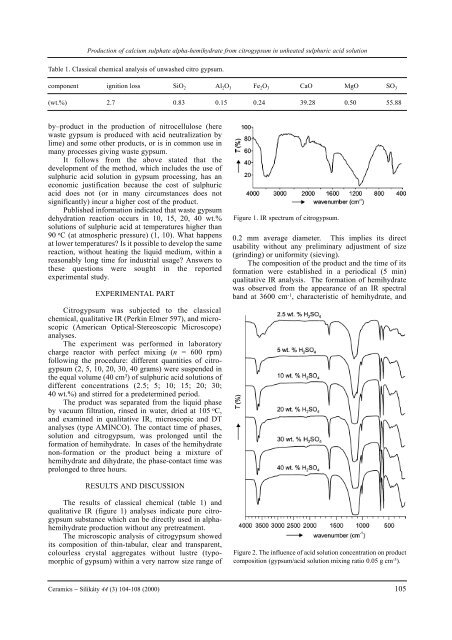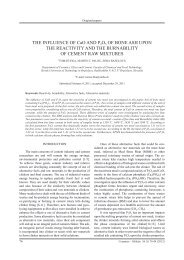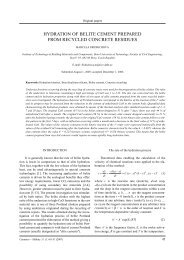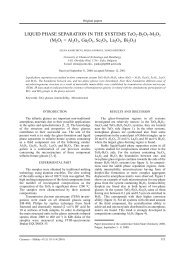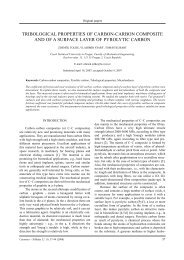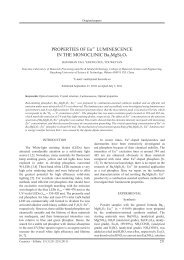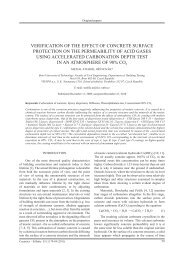Production of calcium sulphate alpha-hemihydrate - Ceramics-Silikaty
Production of calcium sulphate alpha-hemihydrate - Ceramics-Silikaty
Production of calcium sulphate alpha-hemihydrate - Ceramics-Silikaty
Create successful ePaper yourself
Turn your PDF publications into a flip-book with our unique Google optimized e-Paper software.
<strong>Production</strong> <strong>of</strong> <strong>calcium</strong> <strong>sulphate</strong> <strong>alpha</strong>-<strong>hemihydrate</strong> from citrogypsum in unheated sulphuric acid solution<br />
Table 1. Classical chemical analysis <strong>of</strong> unwashed citro gypsum.<br />
component ignition loss SiO 2 Al 2O 3 Fe 2O 3 CaO MgO SO 3<br />
(wt.%) 2.7 0.83 0.15 0.24 39.28 0.50 55.88<br />
by–product in the production <strong>of</strong> nitrocellulose (here<br />
waste gypsum is produced with acid neutralization by<br />
lime) and some other products, or is in common use in<br />
many processes giving waste gypsum.<br />
It follows from the above stated that the<br />
development <strong>of</strong> the method, which includes the use <strong>of</strong><br />
sulphuric acid solution in gypsum processing, has an<br />
economic justification because the cost <strong>of</strong> sulphuric<br />
acid does not (or in many circumstances does not<br />
significantly) incur a higher cost <strong>of</strong> the product.<br />
Published information indicated that waste gypsum<br />
dehydration reaction occurs in 10, 15, 20, 40 wt.%<br />
solutions <strong>of</strong> sulphuric acid at temperatures higher than<br />
90 o C (at atmospheric pressure) (1, 10). What happens<br />
at lower temperatures? Is it possible to develop the same<br />
reaction, without heating the liquid medium, within a<br />
reasonably long time for industrial usage? Answers to<br />
these questions were sought in the reported<br />
experimental study.<br />
EXPERIMENTAL PART<br />
Citrogypsum was subjected to the classical<br />
chemical, qualitative IR (Perkin Elmer 597), and microscopic<br />
(American Optical-Stereoscopic Microscope)<br />
analyses.<br />
The experiment was performed in laboratory<br />
charge reactor with perfect mixing (n = 600 rpm)<br />
following the procedure: different quantities <strong>of</strong> citrogypsum<br />
(2, 5, 10, 20, 30, 40 grams) were suspended in<br />
the equal volume (40 cm 3 ) <strong>of</strong> sulphuric acid solutions <strong>of</strong><br />
different concentrations (2.5; 5; 10; 15; 20; 30;<br />
40 wt.%) and stirred for a predetermined period.<br />
The product was separated from the liquid phase<br />
by vacuum filtration, rinsed in water, dried at 105 o C,<br />
and examined in qualitative IR, microscopic and DT<br />
analyses (type AMINCO). The contact time <strong>of</strong> phases,<br />
solution and citrogypsum, was prolonged until the<br />
formation <strong>of</strong> <strong>hemihydrate</strong>. In cases <strong>of</strong> the <strong>hemihydrate</strong><br />
non-formation or the product being a mixture <strong>of</strong><br />
<strong>hemihydrate</strong> and dihydrate, the phase-contact time was<br />
prolonged to three hours.<br />
RESULTS AND DISCUSSION<br />
The results <strong>of</strong> classical chemical (table 1) and<br />
qualitative IR (figure 1) analyses indicate pure citrogypsum<br />
substance which can be directly used in <strong>alpha</strong><strong>hemihydrate</strong><br />
production without any pretreatment.<br />
The microscopic analysis <strong>of</strong> citrogypsum showed<br />
its composition <strong>of</strong> thin-tabular, clear and transparent,<br />
colourless crystal aggregates without lustre (typomorphic<br />
<strong>of</strong> gypsum) within a very narrow size range <strong>of</strong><br />
Figure 1. IR spectrum <strong>of</strong> citrogypsum.<br />
0.2 mm average diameter. This implies its direct<br />
usability without any preliminary adjustment <strong>of</strong> size<br />
(grinding) or uniformity (sieving).<br />
The composition <strong>of</strong> the product and the time <strong>of</strong> its<br />
formation were established in a periodical (5 min)<br />
qualitative IR analysis. The formation <strong>of</strong> <strong>hemihydrate</strong><br />
was observed from the appearance <strong>of</strong> an IR spectral<br />
band at 3600 cm -1 , characteristic <strong>of</strong> <strong>hemihydrate</strong>, and<br />
Figure 2. The influence <strong>of</strong> acid solution concentration on product<br />
composition (gypsum/acid solution mixing ratio 0.05 g cm -3 ).<br />
<strong>Ceramics</strong> − Silikáty 44 (3) 104-108 (2000) 105


